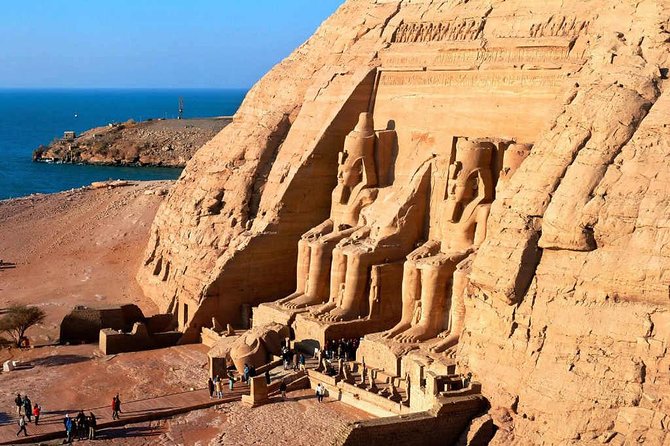🏛️ Abu Simbel Temple – A Legend Carved in Stone
📍 Geographical Location
Abu Simbel Temple is located on the western bank of Lake Nasser, deep in the Nubian desert, about 280 km south of Aswan.
Despite its remote location, it attracts thousands of visitors every year due to its architectural splendor and unmatched historical significance.
🔱 Why Was Abu Simbel Built?
Commissioned by King Ramses II during the 19th Dynasty, the temple served multiple purposes:
-
To glorify the major Egyptian deities: Amun, Ra-Horakhty, and Ptah.
-
To deify Ramses II himself as a living god.
-
To assert Egypt's dominance in the south and deter Nubian threats.
-
To impress foreign nations with Egypt’s power and architectural brilliance.
🏯 The Great Temple – Temple of Ramses II
🗿 The Majestic Facade
-
Carved directly into a solid cliff.
-
Features four colossal seated statues of Ramses II, each around 20 meters tall.
-
The pharaoh wears the double crown, symbolizing the unity of Upper and Lower Egypt.
-
One statue collapsed in antiquity due to an earthquake—left as it is, marking history.
-
Above the entrance, Ra-Horakhty offers the ankh (life symbol) to Ramses—a symbol of eternity.
🏛️ Entrance and Hypostyle Hall
-
Leads into a hall supported by eight massive pillars, each depicting Ramses as Osiris, god of resurrection.
-
Walls are adorned with vivid carvings showing his military triumphs, especially the Battle of Kadesh—the first recorded battle in human history.
-
These scenes depict Ramses charging into battle in a chariot, earning him the title: "The Warrior King."
🌞 Sanctuary & Solar Alignment Phenomenon
-
At the heart lies the sanctuary, with four seated figures: Ra-Horakhty, Amun-Ra, Ptah, and Ramses II.
-
A solar miracle happens twice a year—February 22 and October 22—when sunlight illuminates the faces of Ra, Amun, and Ramses, while Ptah, god of darkness, remains in shadow.
-
This event proves the Pharaohs’ mastery of astronomy and architecture.
👑 The Small Temple – Temple of Queen Nefertari
-
Located 100 meters from the Great Temple.
-
Dedicated to Queen Nefertari, beloved wife of Ramses II.
-
Features six statues: four of Ramses and two of Nefertari, each 10 meters high.
-
For the first time, a queen was portrayed equal in size to the king—reflecting deep affection and respect.
-
Inside, exquisite carvings show Nefertari dancing and offering sacrifices to Hathor, goddess of love and music.
🌍 The Greatest Archaeological Rescue in History
When the Aswan High Dam threatened to flood the temple in the 1960s:
-
UNESCO launched an unprecedented global campaign.
-
The temple was dismantled into over 1,000 numbered blocks and reassembled 65 meters higher.
-
The operation lasted four years (1964–1968) and is considered one of the most significant cultural rescue missions in modern history.
✨ Cultural, Religious, and Touristic Significance
-
Abu Simbel is a timeless message of strength, love, devotion, and genius.
-
It combines art, science, religion, and politics in a single awe-inspiring structure.
-
Today, it is a top destination for cultural tourism, especially during the solar alignment celebrations.
🌄 A Final Invitation
Can you imagine standing before 3,000-year-old statues, carved with breathtaking precision into a Nubian mountain?
Would you like to witness the sun illuminate the face of an eternal king—just as he intended millennia ago?
If you seek an unforgettable experience...
Where stone speaks and walls reveal the secrets of ancient gods and kings...
Abu Simbel awaits you.

